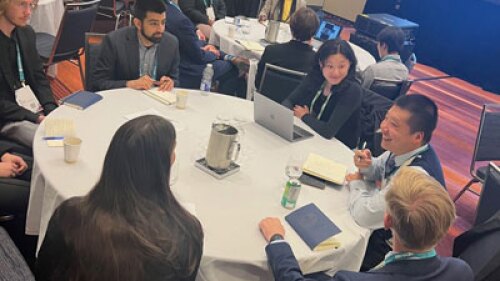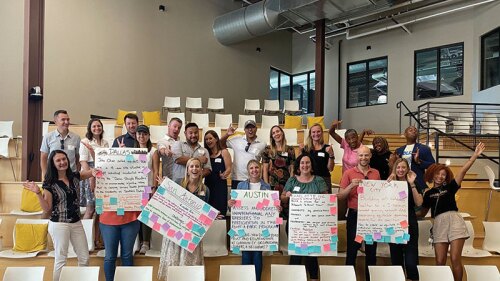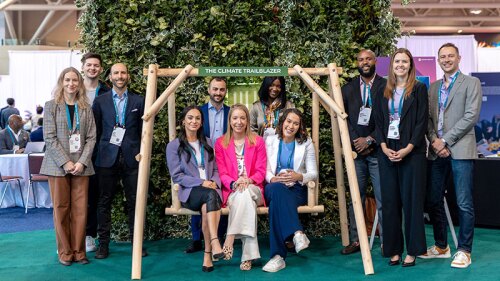What makes this technology capital with its lush, natural landscapes and thriving local culture unique? Meeting cochairs and Foundation governors Greg Johnson and Patrick Callahan explain.
It may be a first for ULI, but kayaks will be the mode of transport for one of the tours that precede the Spring Meeting this year. And why not? Seattle not only lives with water, but also embraces it, having been settled as a shipbuilding and seaport city on the Puget Sound in the mid-1800s. Fast-forward to the 21st century and Seattle is home to the companies that have no less than redefined our daily lives: Amazon, Starbucks, Boeing, and Microsoft. The 2017 ULI Spring Meeting will offer participants a chance to experience first-hand the companies, real estate projects, and neighborhoods that are shaping a city that has grown in influence and stature.
“Historically, Seattle never quite had the profile of a top-tier city in the United States, but has most certainly moved into that elite group over the past ten years,” says Johnson, president of Wright & Runstad Company. “Technology has fueled our growth, but we are also a leader in biotechnology, health sciences, higher education and research, aviation, and global philanthropy. Combine this dynamic economy with unparalleled opportunities for outdoor recreation, cultural amenities, and urban, walkable neighborhoods, and you can see why Seattle is a destination for global talent.”
It is true that Seattle is known for its technology companies, and attendees will be able to explore the Microsoft campus in Redmond, Washington, as well as experience Amazon’s new corporate headquarters during the closing cocktail reception. But the bigger story, Johnson and Callahan say, is just how deep and diversified the technology sector has become. The behemoths—Amazon and Microsoft among them—have spawned smaller and more specialized firms, creating demand for new types of workspaces and recruiting new cohorts of educated workers from around the world.
In addition, the Seattle metropolitan area is now the market leader for aerospace, cloud computing, online gaming, and medical research—all high-growth, high-wage industries. The city of Bellevue is also nurturing its own innovation ecosystem through the Global Innovation Exchange (GIX), a one-of-a-kind campus and partnership between the University of Washington, Tsinghua University in Beijing, Microsoft, and other leading tech companies. GIX’s mission is to cultivate tech-savvy, design-oriented, and entrepreneurial leaders for the global economy. Participants on the Microsoft tour will get a peek at this exciting new model of higher education as well as experience GIX’s new home—the mixed-use Spring District, developed by Wright & Runstad and other partners.
Register Now for the Spring Meeting
Tech Talent Driving Growth and Building Boom
“What we’re seeing now is the evolution of the technology sector in the Seattle market, and it’s been extraordinary to watch,” Callahan, founder and chief executive officer of Urban Renaissance Group, says. “Our story has ramifications for the rest of the country since technology is interwoven into everything we do and as a sector is shaping local and regional economies everywhere.”
In fact, Seattle’s technology economy and the talent pool have created a kind of virtuous cycle, constantly replenishing itself and turning on its head the idea that companies alone are driving the growth. “We’ve gotten to the point where companies are relocating to Seattle or choosing to start their companies here because of the talent, rather than the other way around,” Johnson says.
Global technology firms have clustered in the South Lake Union neighborhood, where Google and Facebook have opened offices and where Amazon launched the first phase of its new $4 billion downtown headquarters—the 500-foot-tall (152 m) Doppler building—in 2015. By 2018, four additional buildings and a striking centerpiece—three glass dome greenhouses where Amazon employees will be able to work amid lush gardens and trees—will complete the campus. Attendees will be able to tour South Lake Union to see how these urban campuses are upping their game.
Amazon is far from the only Seattle-based company to relocate from the suburbs to downtown in a bid for employees who thrive in urban environments. Weyerhaeuser, the largest private owner of timberlands in the United States, recently relocated from Federal Way to Pioneer Square, a culturally rich and historic downtown neighborhood. The urban migration of companies is driving two other trends, which participants will see first-hand: a boom in downtown residential development and further investments in transit. Of the roughly 65 buildings under construction in downtown Seattle, two-thirds are for new residential projects that cannot seem to be built fast enough to meet demand.
Callahan explains that a zoning change approved ten years ago exempts new residential development from floor/area ratio (FAR) requirements, unleashing a building boom of new apartments—10,000 are set to open this year—and tempered an overheated housing market. “The amount of in-migration to Seattle has been extraordinary,” he says. “If we hadn’t been able to deliver this supply, who knows where housing prices would be.”
Johnson notes that voters recently approved a $54 billion transportation package that will expand Sound Transit and strengthen connections between housing and job centers. (The system already offers connections between the SeaTac Airport, the city, and the University of Washington.) Seattle’s investment in transit will be on display with a streetcar and light-rail tour of innovative transit-oriented developments, including Pine + Minor, a multiblock, mixed-use project developed by Gerding Edlen at the new Capitol Hill light-rail station.
A City of Innovators
In addition to showcasing Seattle’s innovative real estate and vibrant neighborhoods, the meeting provides attendees an opportunity to learn from local leaders who are transforming their respective industries. Attendees will hear from Amazon and Nordstrom on new ways of delivering the retail experience as well as new methods of distributing goods to people as e-commerce and on-demand delivery dominate the consumer landscape. Seattle native Bradley Tilden, chairman and chief executive officer of Alaska Airlines, will share his experience leading a consistently profitable airline during a fireside chat.
There is no doubt that from its founding, Seattle has been a city of innovators. From the gold rush to the heyday of logging and shipbuilding and through to the digital age, the city has always been on the pioneering edge of industry. In fact, a short walk from the Washington Convention Center are companies and landmarks that capture the panorama of Seattle’s past and future. “This is definitely a ‘Bring your walking shoes kind of place,’” Johnson says. “Come to the 2017 ULI Spring Meeting in Seattle and see for yourself the energy and vitality that have made our city a leader in so many areas. Experience the texture and vibrancy of Pike Place Market, Pioneer Square, and other places that make our city special. All of it is just a short walk away.”




